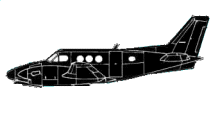
ASN Wikibase Occurrence # 262118
This information is added by users of ASN. Neither ASN nor the Flight Safety Foundation are responsible for the completeness or correctness of this information.
If you feel this information is incomplete or incorrect, you can submit corrected information.
| Date: | Friday 25 June 1999 |
| Time: | |
| Type: |  Beechcraft B90 King Air |
| Owner/operator: | Stone Aviation LLC |
| Registration: | N221NC |
| MSN: | LJ-393 |
| Year of manufacture: | 1968 |
| Total airframe hrs: | 8716 hours |
| Engine model: | P&W PT6A-20 |
| Fatalities: | Fatalities: 0 / Occupants: 7 |
| Aircraft damage: | Substantial |
| Category: | Accident |
| Location: | Creede, CO -
 United States of America United States of America
|
| Phase: | Landing |
| Nature: | |
| Departure airport: | OKLAHOMA CITY, OK (PWA) |
| Creede, CO | |
| Investigating agency: | NTSB |
| Confidence Rating: |
On June 25, 1999, at 1317 mountain daylight time, a Beech B90, N221NC, was substantially damaged when it collided with terrain while landing at Mineral County Memorial Airport, Creede, Colorado. There were no injuries to the commercial pilot in command, the private pilot receiving instruction, five passengers, and a dog. Visual meteorological conditions prevailed, and an IFR flight plan had been filed. The flight originated in Oklahoma City, Oklahoma, at 1120 central daylight time.
The flight instructor said the airplane felt like it was being pushed down onto the runway. As power was added, the airplane touched down 'approximately 90 KIAS (a loss of 10 to 15 knots indicating a shear)' and there was a loud 'bang.' The airplane became airborne momentarily, then touched down again. The airplane departed the right side of the runway on its nose and left main landing gear. The owner-pilot receiving instruction said 'the bottom fell out and a moderately hard landing was made on the main gear. A pilot who witnessed the accident landed hard moments before. He said he had encountered a 'vertical wind shear.' He saw a large puff of blue gray smoke come out from beneath the right wing, followed by the tumbling right main gear. Metallurgical examination of the right scissors torque link disclosed multiple fractures and a crack in the upper link. The fractures were 'typical of fatigue cracking,' originating from 'multiple sites.' There was also corrosion pitting. Two other fracture sites were 'indicative of overstress.'
Probable Cause and Findings
The National Transportation Safety Board determines the probable cause(s) of this accident to be:
Overload failure of the right main landing gear scissors torque link precipitated by preexisting fatigue fractures. A factor was wind shear.
Accident investigation:
 |
|
Sources:
NTSB
Revision history:
| Date/time | Contributor | Updates |
|---|---|---|
| 20-May-2021 17:25 | ASN archive | Added |
| 20-May-2021 17:48 | harro | Updated [Total occupants, Phase, Departure airport, Destination airport, Narrative, Accident report] |
Corrections or additions? ... Edit this accident description
The Aviation Safety Network is an exclusive service provided by:


 ©2024 Flight Safety Foundation
©2024 Flight Safety Foundation